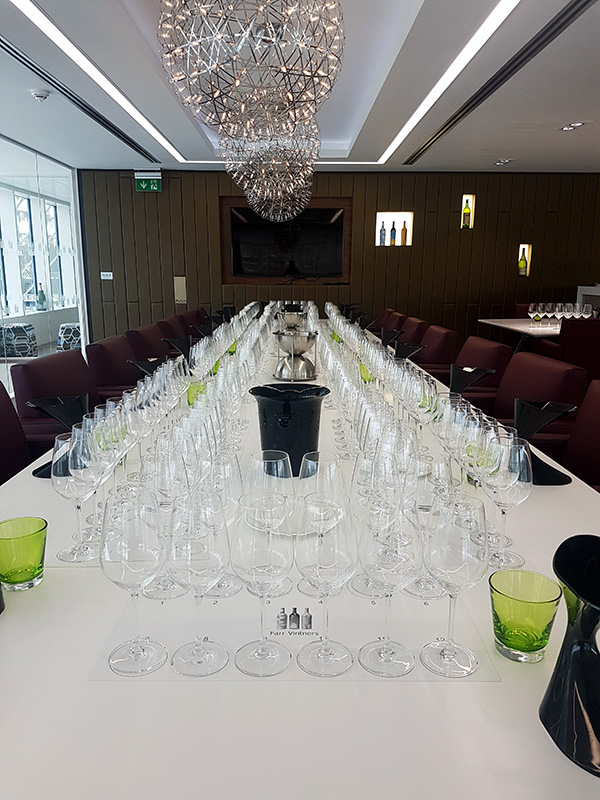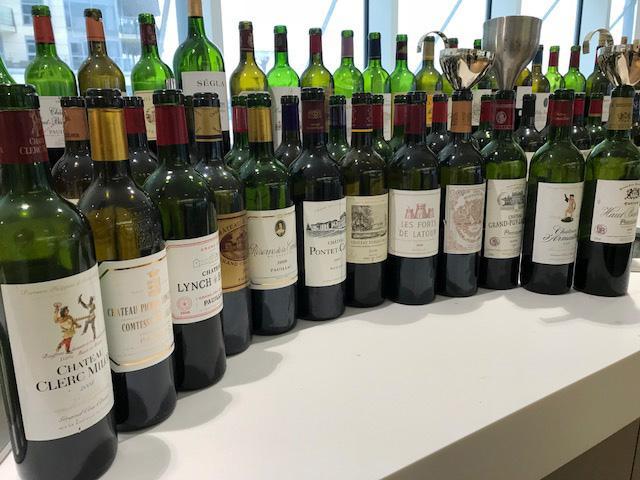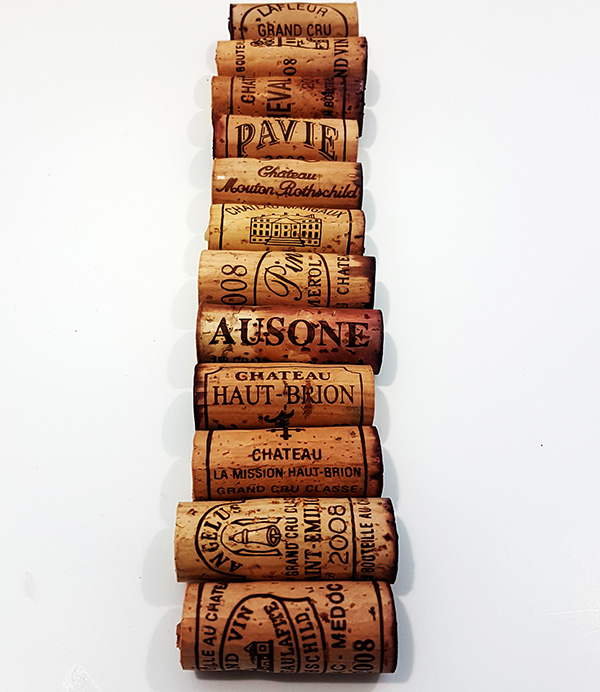Since the early 1990’s I have been a member of the original “Ten Years On” t.asting group that was founded by the late, great Bill Baker using the reserve bottles from the original Southwold tastings. The first of these tastings that I attended was in 1992 when we looked back at the still youthful but already magnificent 1982’s We tasted further vintages at Barry Phillips’ “White Horse Inn at Chilgrove” and Bill’s “The Mill” at Hallatrow before settling on Farr Vintners as our home ground some years ago. As with the Southwold tasting, we are a group of wine writers – Jancis Robinson, Neal Martin, Steven Spurrier – and wine merchants (including the buyers of most of the major UK wine importers).

Farr Vintners' tasting room ready for action |
On the 10th Anniversary of a vintage we taste the wines in our usual format. Strictly blind in flights of 12. They are served in “peer groups” so that wines from similar areas and at similar prices are compared to each other. This year we had 150 wines from the 2008 vintage to assess and the tasting took place over 2 days in early March 2018 in our riverside tasting room in Battersea as the “Beast from the East” blew in along the Thames.
2008 is an interesting vintage that began life in controversial circumstances. Most of the UK wine trade had decided that it was an average year, slightly superior to 2007 but nothing to write home about. Then, all of a sudden, with the en primeur campaign already under way, Robert Parker (who was at this time at the height of his power and influence) shocked us all with an astonishing report where he pronounced that 2008 was “an excellent, and in some cases, a great vintage…..with a number of superb wines that are close to, if not equal to the prodigious 2005 or 2000 vintages.” Having expected a lukewarm en primeur campaign, consumer interest suddenly soared and those proprietors who had released pre-Parker (Pichon Lalande was £465, Angelus £725, Latour £1590) must have regretted their decisions as prices rose dramatically following the excessive Parker scores.
Hindsight shows us that Mr Parker called this vintage wrong and he had to back-track dramatically when he subsequently tasted the wines in bottle and a real “vintage of the century” had subsequently appeared with the arrival of 2009. So, now that the fuss has died down, how do the wines taste at 10 years old? What are the best wines of the vintage and how does this vintage compare to others of recent times?

Some of the big names in 2008 |
At the recent Southwold tasting of 2014 Bordeaux, much was made of the comparison of the vintage to 2008. However, having now tasted through both vintages in quick succession, there are clear stylistic differences and most put the 2014 vintage at a higher quality than 2008. While these are both fresher styled “classic” vintages, the ripeness of fruit and refinement of tannins for the 2014s certainly seem to outdo the 2008s. At ten years old, most of these wines are now into their drinking window. The fruit still provides the thrust of aromatics and flavour, but the tannins are softening and offering approachability in all but the very top (or over extracted) wines. Savoury notes are starting to come through. The acidity is fresh in 2008, and the best wines use it to their advantage to offer floral lift and cool black fruits. Those who were not careful to manage this aspect could leave sour, jarring finishes that seem as if they will never resolve. Getting enough flesh in the wine was paramount, which many did admirably. Again, however, many wines seem a touch lean, especially when compared to the two vintages that followed. We seldom saw the “gorgeously ripe fruit(…) and remarkable density as well as concentration” of which Mr Parker spoke. When it was ripe, Cabernet Sauvignon clearly dominated in this vintage Pauillac and St Julien both showed well. Pessac stood out, the added flesh of Merlot and warmer conditions near the city of Bordeaux certainly seemed to help temper the acidities. Warmer sites, in general, fared well. The Sauternes in general did not shine, and with such a choice of excellent recent vintages around it, there seems very little reason to own sweet Bordeaux from 2008.

2008 Pauillacs |
Running through the appellations it is remarkable how similarly the wines performed in comparison to the Southwold tasting of January 2012.
Saint Emilion – leaving aside the First Growths, our winner at Southwold was Le Tertre Roteboeuf and it was again in 2018. Also on the podium this time were Canon and Figeac. This vintage was made at the height of “Parker Power” and many of the more jammy, extracted wines showed badly and are certainly not to the taste of British panel of judges.
Pomerol – Likewise, our winner this year was the same as our winner previously - L’Eglise Clinet coming out on top yet again. Pomerol showed well in comparison to Saint Emilion in this vintage, largely due to a lighter touch in the wineries.
Pessac-Leognan – Our winner this time round was a fleshy and seductive Pape Clement followed by Smith Haut Lafitte, Domaine de Chevalier and Haut Bailly (which had won at Southwold). These top wines showed well, and are worthy additions to the cellar at reasonable prices.
Margaux – No surprises here with Palmer the winner originally and again at “10 Years On”. This is a fine and supple Palmer that topped its commune with virtually the same score as the “super-second” winners in St Julien, St Estephe and Pauillac.
St Julien – As it was in Southwold our winner here was Léoville Poyferré. In a slightly lean vintage the impressive flesh and spice of this 2nd growth stood out. There was great consistency in St Julien, with the highest rated “losing wine” in its flight. There were no bad wines from this appellation.
Pauillac – Yet again we had a repeat winner with Pichon Baron emerging triumphant at both tastings. I don’t think that any Chateau has consistently won so many blind tasting as the Baron. Duhart Milon did will to come second in a strong field.

1st Growth Corks |
St Estephe – There was no surprise that the top three here were Cos d’Estournel, Montrose and Calon Ségur and that was the order in which they finished.
First Growths – Our top right bank wines were Le Pin – a supple, creamy, delicious sex bomb for those who can afford it, and Ausone. However the left bank triumphed with our top 4 of the entire tasting being (in this order) – Latour, Haut Brion, Mouton and Lafite. (Haut Brion had won at Southwold and was pipped to the post this time by just 0.04 points!).
Sauternes – There were highs and lows in the tasting of the sweet wines, though the lows far outweighed the highs. Many were flabby and lacking in the complexity, acidity and balance that noble rot provides when conditions are right. La Tour Blanche was the winner thanks to its weight and lifted acidity. Yquem, Suduiraut and de Fargues were in a tie for 2nd place.
Value - The most modestly-priced wine to score well in this tasting was Tronquoy Lalande (from the owners of Montrose). This Saint Estephe finished above many classed growths and was ranked the 4th best in its appellation. This sub £20 wine beat the likes of Pavillon Rouge, Clarence Haut Brion and Petit Cheval – an impressive performance when one considers that those wines sell at around five times the price.
Our conclusion at the end of this tasting was that 2008 is an attractive and useful vintage. It is clearly not to be compared to outstanding years like 2000, 2005, 2009 and 2010 (with 15 and 16 waiting in the wings). It’s better than 2013, 2011, 2007, 2004 and 2002 and somewhere similar in quality to 2012 or maybe 2014. The great advantage that they have is that they are ready to drink and will continue to be at their best over the next 10 years or so. Whilst the 2007’s need to be drunk up and the top 2009’s and 2010’s are not quite ready to drink, this is a useful and modestly priced vintage that fills a gap in the market offering the consumer traditionally proportioned wines to enjoy now.

And the winner is...Latour 2008 |
This is how I would now rate the red Bordeaux vintages 2000 – 2014. Next January we will taste 2015 in bottle for the first time and the 2009 “10 Years On”.